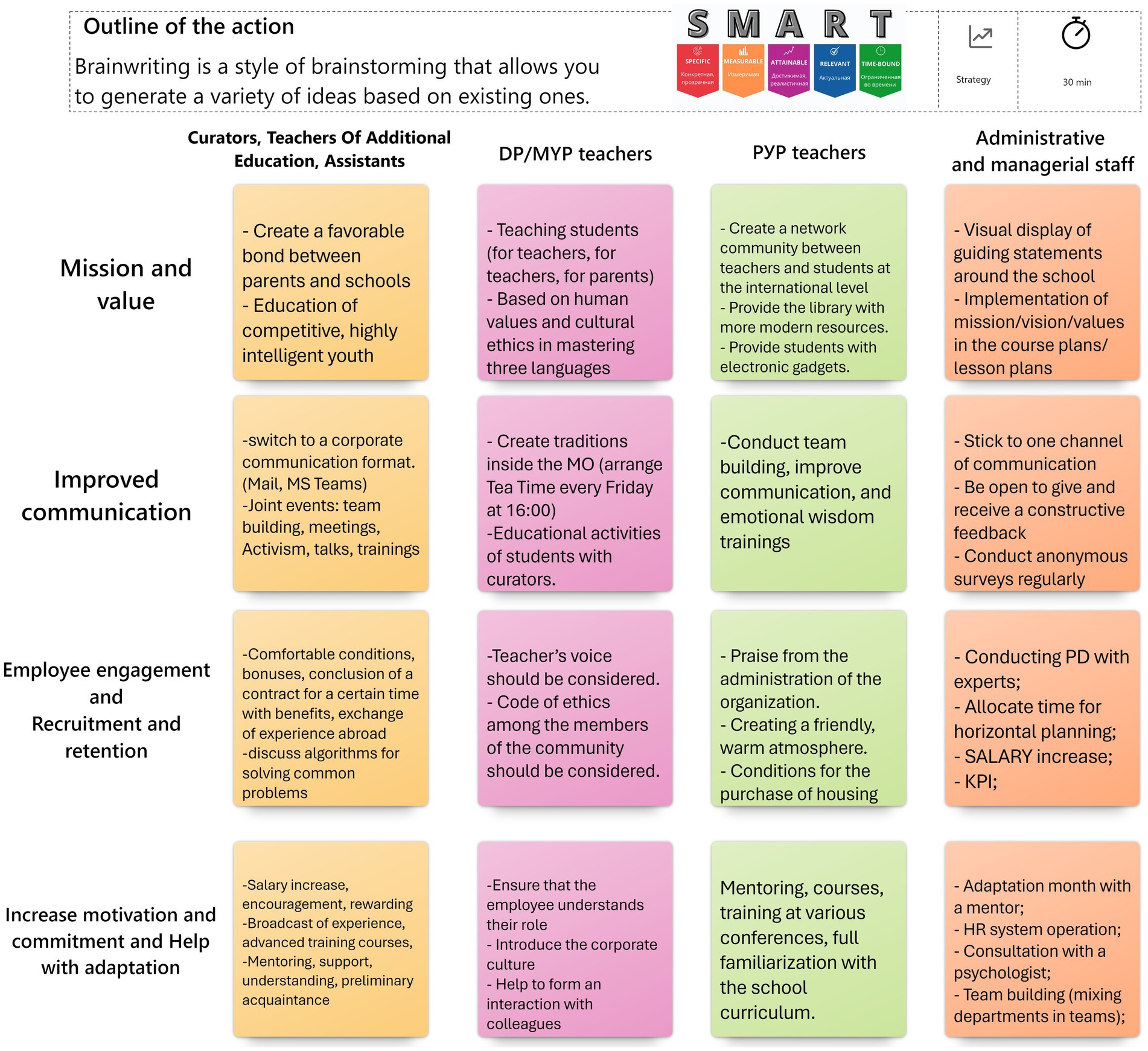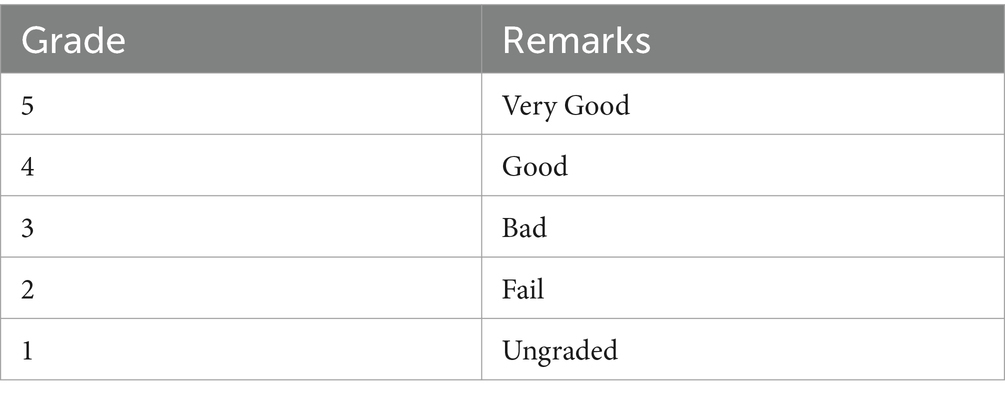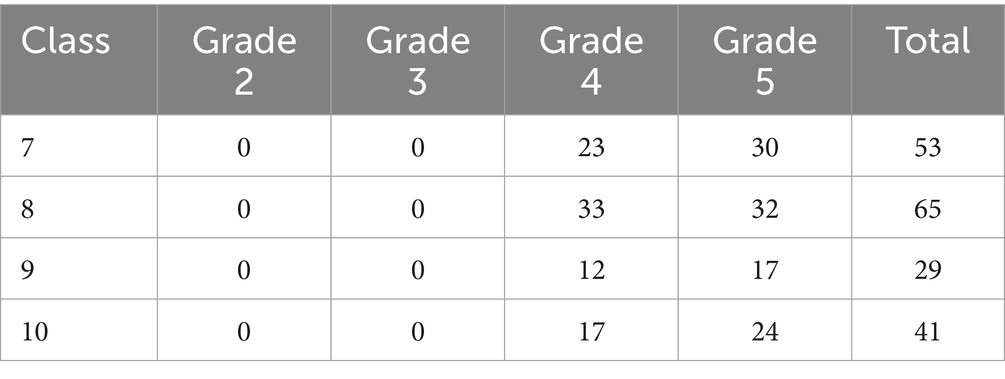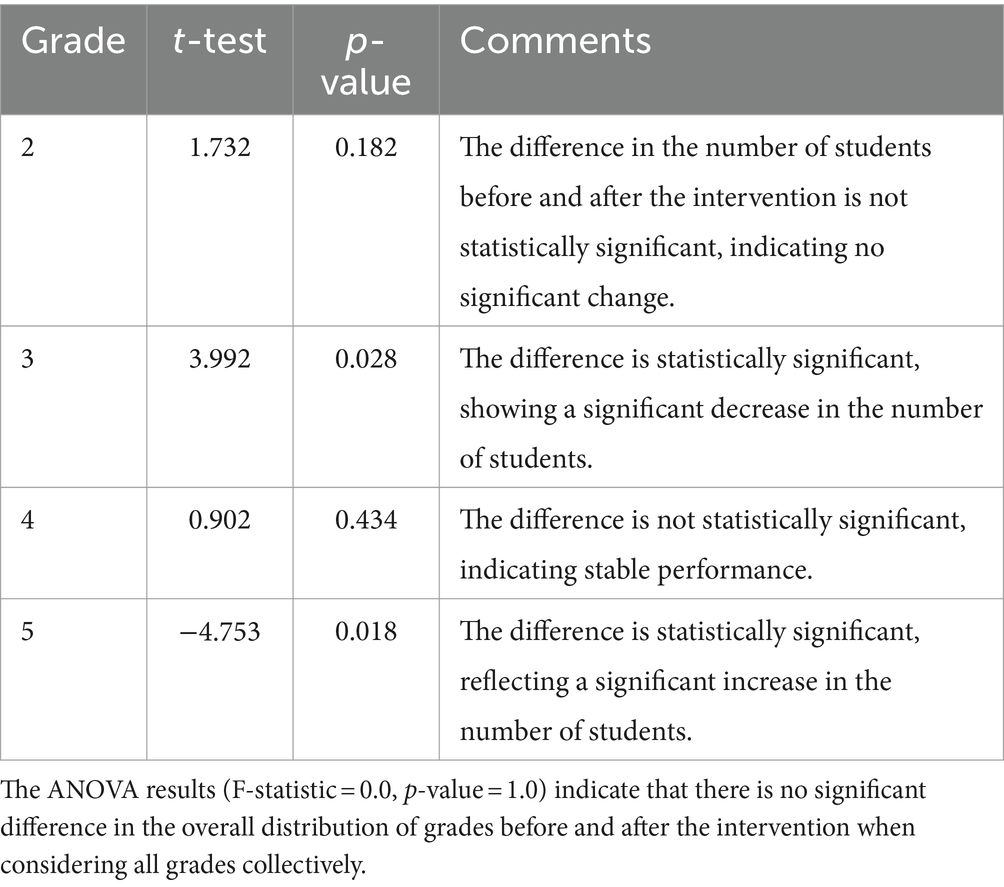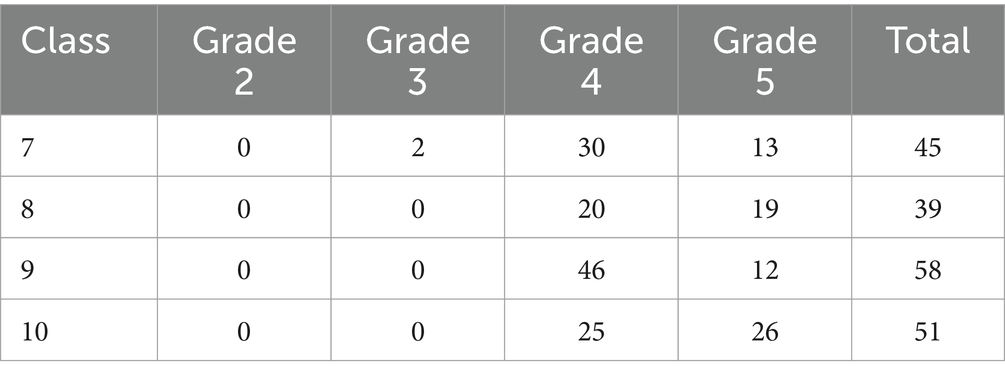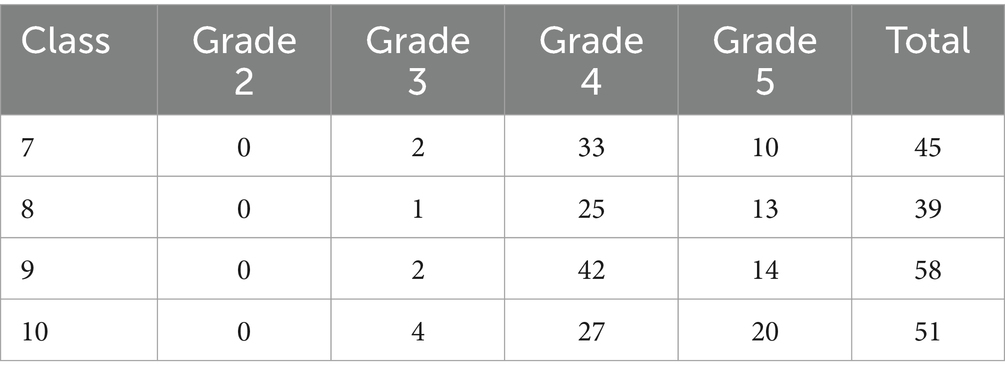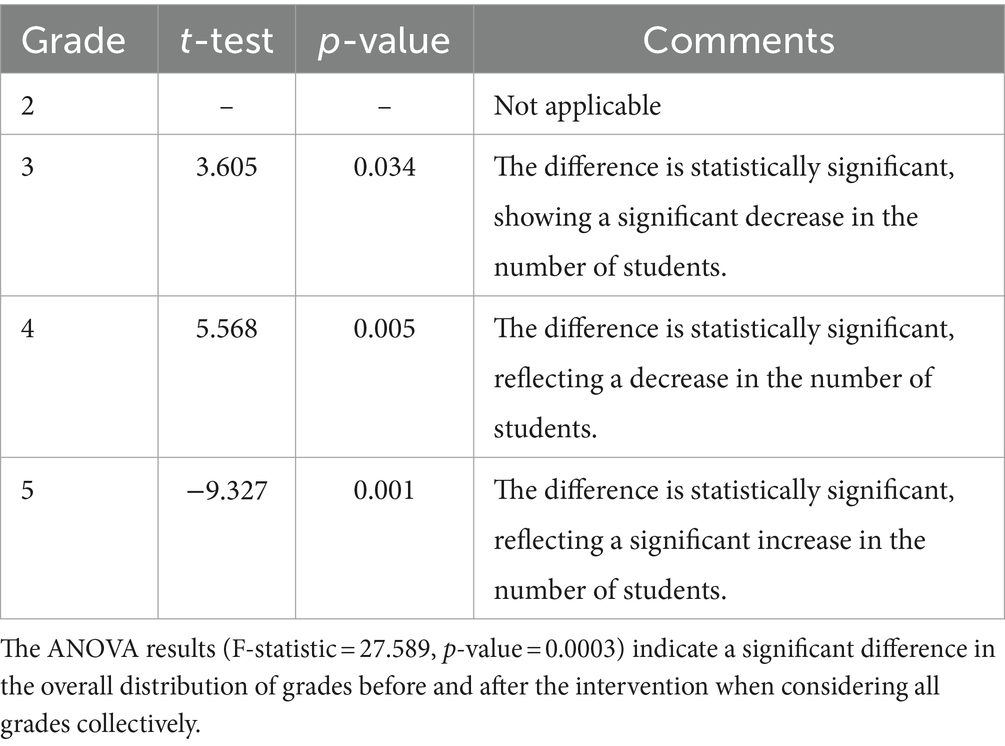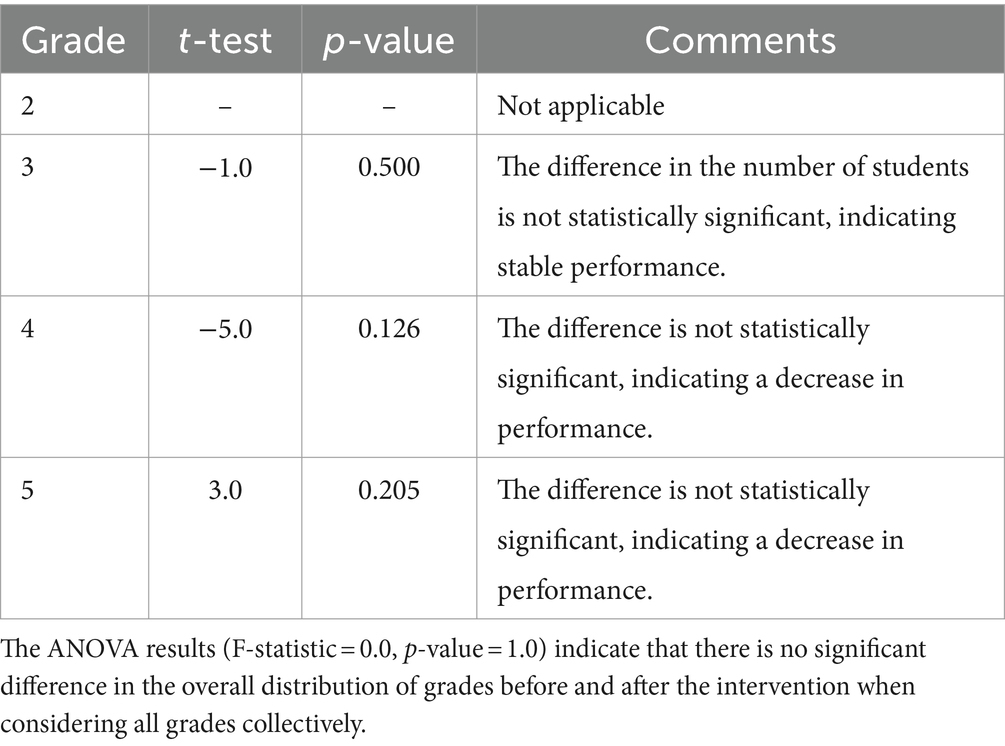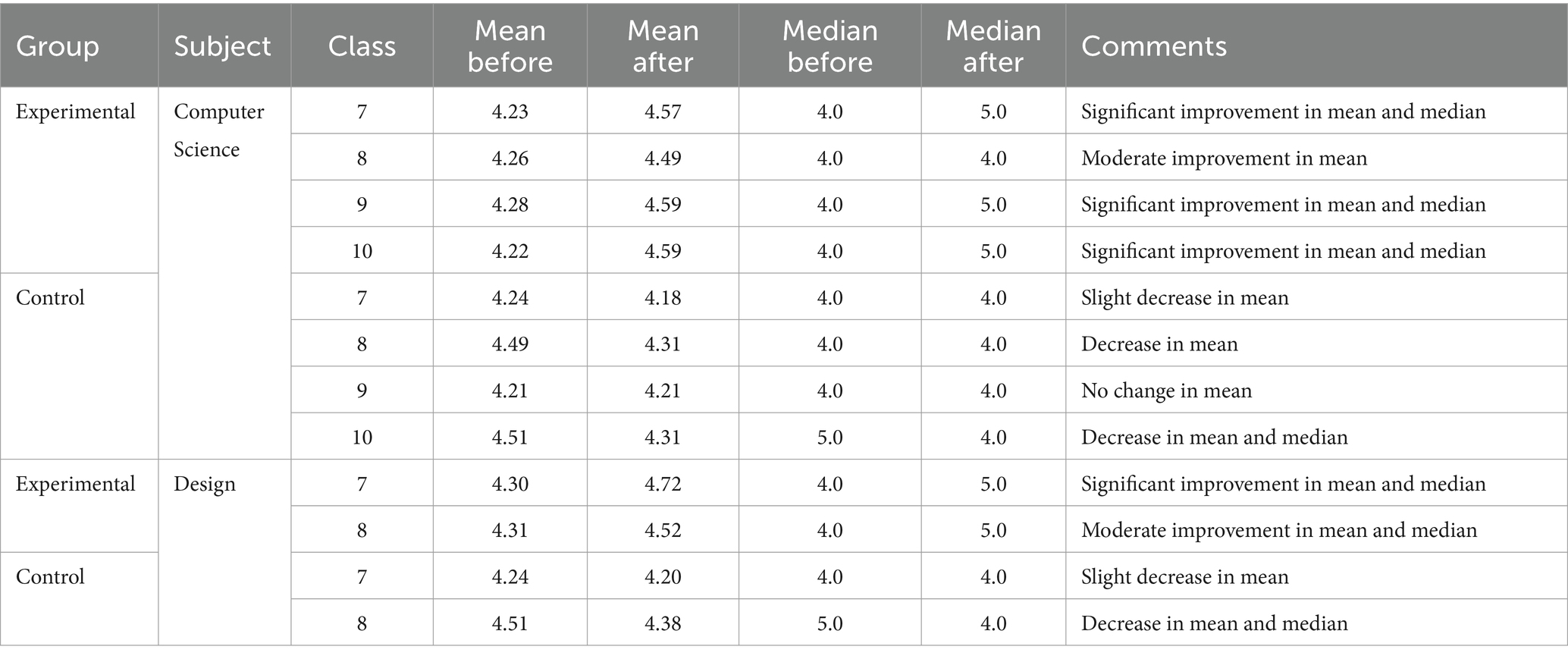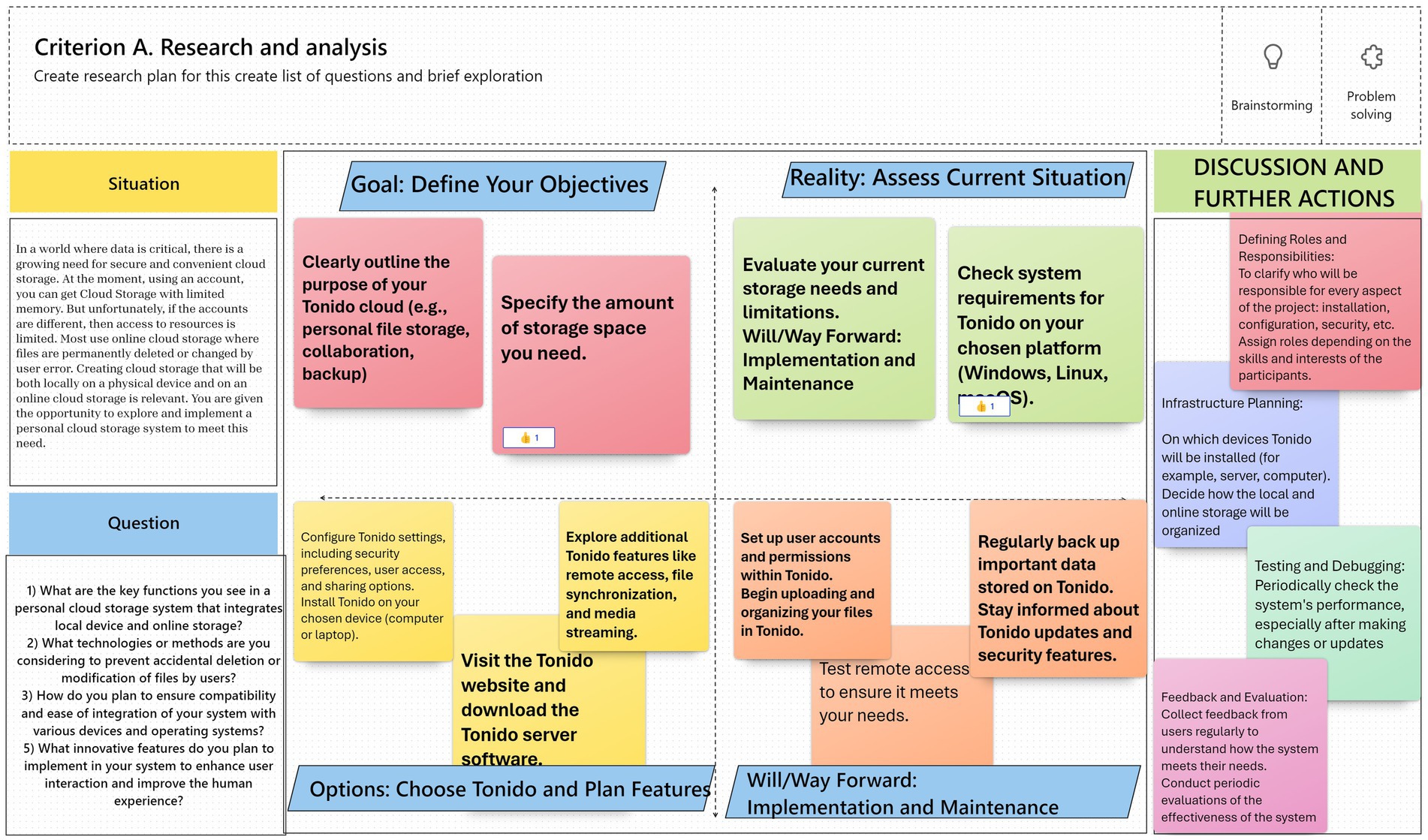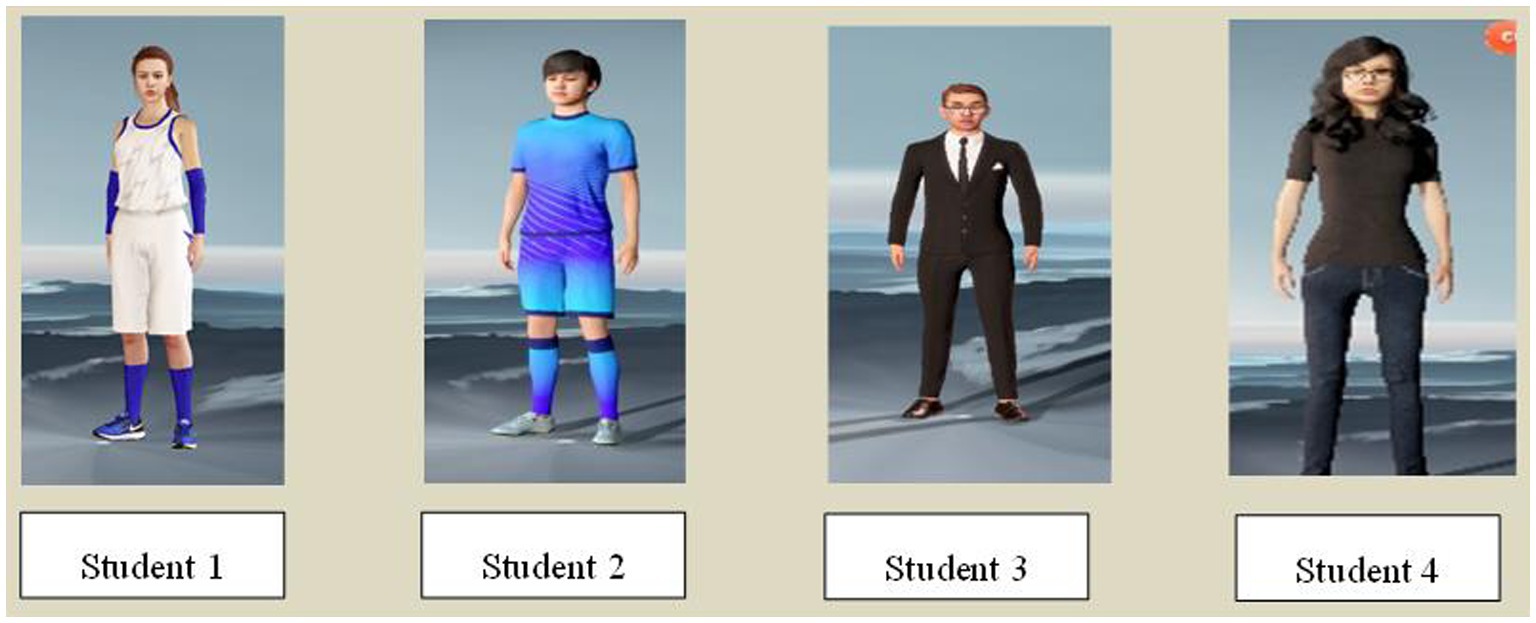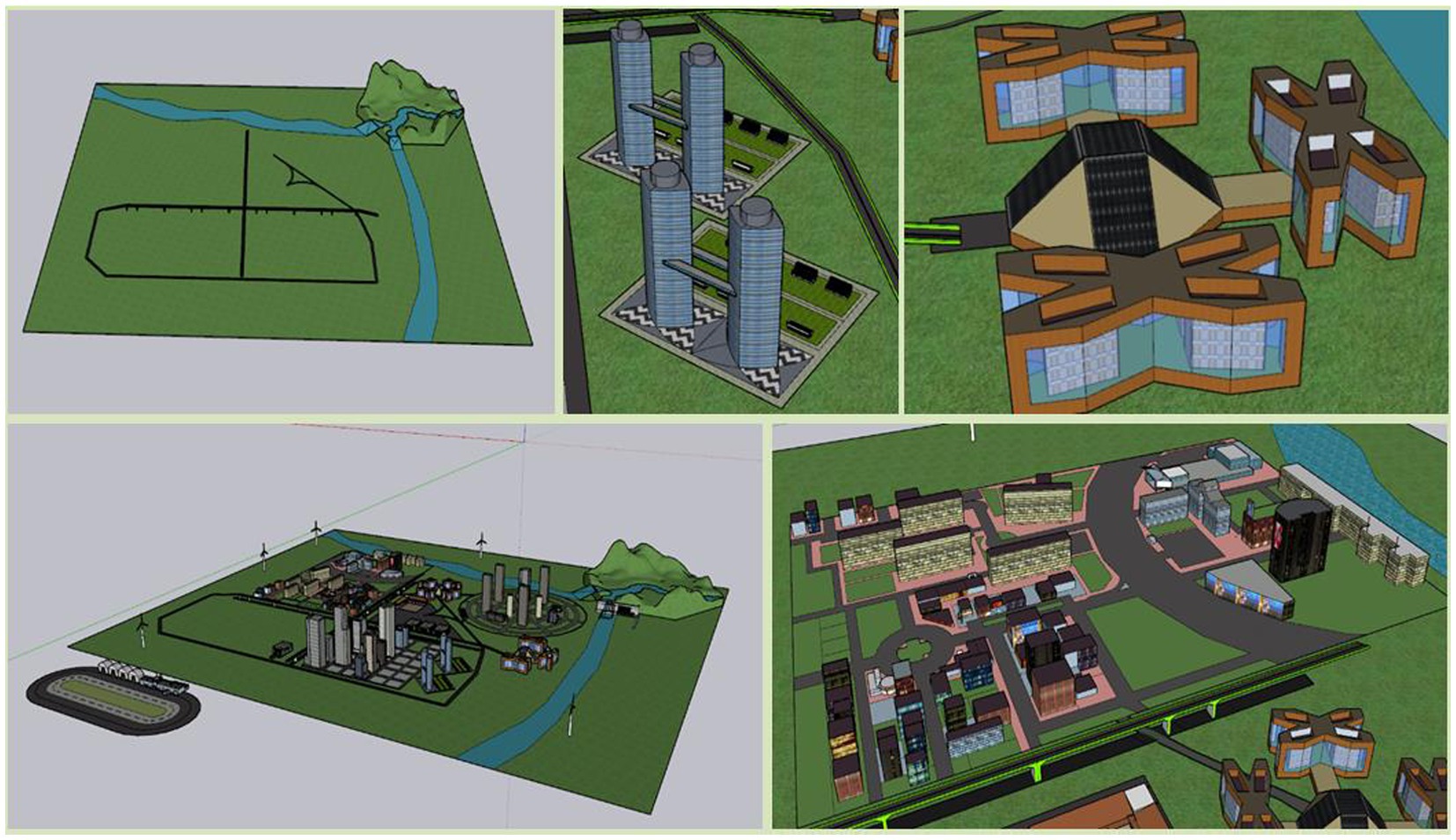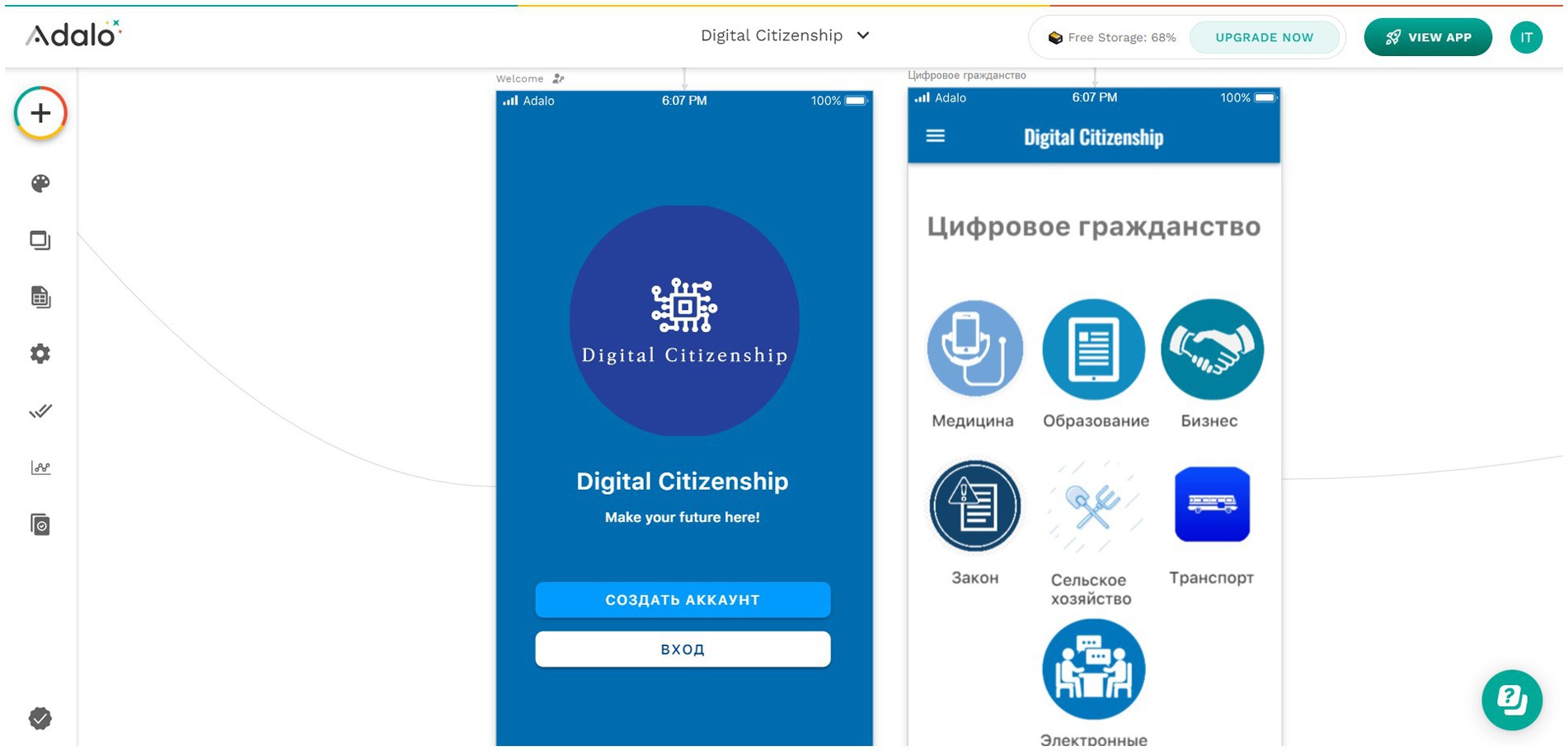- 1Faculty of Information Technology, Department of Computer Science, L.N. Gumilyov Eurasian National University, Astana, Kazakhstan
- 2Technical Sciences Vocational School, Aksaray University, Aksaray, Türkiye
This study explores the development and impact of digital literacy skills among teachers at Astana International School, Kazakhstan, and examines how these skills influence the teaching of Computer Science and Design to middle school students. Employing a mixed-methods approach, the research combined quantitative assessments of students’ proficiency with qualitative evaluations of teacher and student experiences, involving 71 teachers and 382 students from grades 7 to 10. The findings indicate that students taught by digitally literate teachers demonstrated significant improvements in designing and utilizing virtual reality tools, mobile applications, and other digital resources, with teachers facilitating more interactive and engaging learning environments that enhanced students’ technical skills and creative capacities. This research contributes new insights into the dynamics of digital literacy in education, emphasizing the critical role of teacher training in digital tools for enhancing educational practices and uniquely demonstrating how systematic application of digital literacy can transform educational outcomes, supporting the integration of technology in teaching, aligned with the needs and competencies of Generation Z students.
1 Introduction
The digital transformation of educational environments is an undeniable facet of modern teaching and learning landscapes, underscored by the integration of digital tools across various learning platforms. At the heart of this transformation is the imperative for educators to develop robust digital literacy skills. Such skills are crucial for effectively harnessing digital tools in teaching disciplines like Computer Science and Design, particularly when addressing the needs of Generation Z students. The necessity for robust digital literacy among educators, especially in disciplines such as Computer Science and Design, remains a significant challenge. This study, conducted at Astana International School, Kazakhstan, seeks to explore the development and impact of these digital literacy skills among teachers.
Compared to previous generations, Generation Z, comprising the current cohort of students, demonstrates a heightened proficiency in utilizing digital technology tools. Generation Z comprises digital natives (Seemiller and Grace, 2019). They have never known a world without the Internet. This unique characteristic sets them apart from previous generations. Technology has been embedded in their daily lives from an early age and is far more accessible to them than it was to any prior generation (Turner, 2015). Advances in multimedia technologies through tablets and smartphones which integrate functionalities of cell phones, media players, cameras, and Internet capabilities into a single device have shaped Generation Z. This exposure has cultivated an environment where continuous connectivity is the norm, profoundly influencing their modes of interaction and communication.
The study at Astana International School offers a unique case for investigating how enhanced digital literacy among teachers can impact the integration of Computer Science and Design education. This is particularly relevant given the school’s commitment to leveraging cutting-edge technology in its curriculum, catering to a student body that epitomizes Gen Z.
The primary objectives of this research are to evaluate the effectiveness of digital literacy training for teachers and its subsequent impact on teaching methodologies that resonate with Generation Z’s learning preferences. By outlining these objectives, this paper sets the stage for a detailed examination by mixed-methods approach effects of improved teacher digital literacy on student learning outcomes.
The swift progression of technology has precipitated a profound change in the landscape of education, giving rise to the digital transformation of learning environments (Almenara et al., 2022). Educational institutions on a global scale have embraced this transformative shift, actively incorporating digital tools and platforms into their pedagogical practices to augment and optimize teaching and learning processes (Martí et al., 2022; Peñafiel et al., 2023). This adoption underscores the recognition of technology as a potent facilitator in advancing educational methodologies and the ongoing evolution of educational paradigms in response to technological advancements.
2 Literature review
The literature review underscores the potential of Augmented Reality (AR) applications in teaching STEM subjects at the high school level in Kazakhstan. It emphasizes the need for standardized assessment tools and the mitigation of technostress in students (Mukhtarkyzy et al., 2023). Another study from Kazakhstan contributes insights from implementing an AR application in Physics lessons, showcasing its efficacy in improving student retention and understanding of complex concepts (Mukhtarkyzy et al., 2022). Further research supplements this narrative by exploring the impact of gamified educational resources on student motivation and academic performance in a university setting in Kazakhstan (Tokzhigitova et al., 2023). These sources provide a comprehensive foundation for understanding the diverse applications and challenges of integrating innovative technologies into education, such as AR and gamified platforms. The synthesis of these findings serves as a valuable reference for educators and developers seeking to enhance digital literacy skills among teachers, fostering an environment conducive to the successful amalgamation of Computer Science and Design education in Kazakhstan and beyond.
Teaching computer programming to elementary and high school students aims to foster computational thinking skills that extend beyond the mere act of programming. Consequently, instruction in computational programming is a precursor for the broader development of computational thinking skills, which possess transferable applications across various knowledge domains. This signifies that these skills are not confined solely to the Computer Science discipline but have a pervasive impact across the entire spectrum of science, technology, engineering, arts, and mathematics (Belmar, 2022).
Furthermore, the Technological Pedagogical Content Knowledge (TPACK) framework elucidates the integration of technology with pedagogy and content knowledge, critical for educators to effectively teach these interdisciplinary skills. Developed by Koehler and Mishra (2008), TPACK helps in understanding how technology can enhance teaching and learning by synergistically combining these knowledge domains. This framework is especially pertinent in evaluating the effectiveness of digital literacy training programs, such as those at Astana International School, ensuring that teachers are equipped not only with technological skills but also with the pedagogical and content knowledge necessary to integrate these technologies effectively.
Computational thinking, a foundational skill crucial for the economic, scientific, and technological progress of the twenty-first century, comprises the skills of decomposition, debugging, algorithmization, abstraction, and problem-solving. Cultivating computational thinking through education is imperative for nations to position themselves advantageously in the global arena and facilitate attaining welfare goals for their populations. Although certain countries have incorporated these subjects into their curricula, global disparities exist in implementing computational thinking education (Belmar, 2022). In this context, the TPACK framework, which integrates Technological Knowledge (TK), Pedagogical Knowledge (PK), and Content Knowledge (CK), is particularly relevant. TK involves the understanding and use of digital tools, while CK refers to the subject-specific knowledge in Computer Science and Design. The interplay between TK and CK is crucial, as it enables educators to effectively incorporate digital components into their teaching, thereby enhancing the overall learning experience. These variations underscore the need for concerted efforts to bridge the gap and ensure a more equitable integration of computational thinking skills worldwide.
The influence of Computer Science on education spans a broad spectrum. Beyond traditional undergraduate education, there is a burgeoning interest in integrating computational thinking throughout the entire educational spectrum, from kindergarten through Class 12. Computer scientists recognize the intrinsic value of thinking abstractly and operating at multiple levels of abstraction. They emphasize the importance of abstracting ideas to effectively manage complexity, scaling through abstraction, embracing iterative processes, and employing robust practices such as debugging and software testing (Yeni et al., 2023). This holistic approach aims to instill technical proficiency and foundational problem-solving and analytical skills applicable across diverse contexts.
The imperative for schools extends beyond the mere teaching of programming. They must actively guide young individuals in navigating the intricacies of the digital world. Computer science is the language of this century, and it is essential to adapt and inculcate digital literacy skills in students. Thus, schools are primarily tasked with instilling computational thinking skills in the youth and enabling them to operate adeptly in the contemporary digital landscape. Traditionally, efforts have focused on training students to use existing computational tools, an approach deemed insufficient to meet the demands of the present century. The essence of the 21st century lies in acquiring computational thinking skills and fostering a novel problem-solving and critical thinking approach. The shift required is from instructing students to be mere users of evolving technology to empowering them as creators of new technologies (Peñalvo, 2018).
The operationalization of computational thinking finds its expression through computer programming, a process that facilitates the central abstraction inherent in computational thinking (Sentance and Barendsen, 2018). Through programming, individuals are provided with a tangible means to engage with and apply the abstract concepts that form the core of computational thinking. Integrating computational thinking principles into programming endeavors is a practical and effective method to enhance understanding and proficiency in the broader context of problem-solving and analytical reasoning. The assertion underscores the symbiotic relationship between computational thinking and the practical application of these principles in computer programming (Grover and Pea, 2018).
This literature review underscores the significance of teaching computer programming to students to foster computational thinking skills. It emphasizes the broad applications of computational thinking across diverse knowledge domains and highlights the global imperative for cultivating computational thinking skills in education. The literature review provides a comprehensive understanding of the importance of computational thinking skills and their integration into education. It serves as a foundation for the case study on enhancing digital literacy skills among teachers for effective integration of Computer Science and Design education at Astana International School, Kazakhstan.
Conclusively, the reviewed literature highlights the critical need for integrating technology with pedagogy and content knowledge as stipulated by the TPACK framework. This integration is not only pivotal for enhancing teaching efficacy but also crucial for improving student outcomes in technologically enriched environments. These insights strongly support our research hypotheses that teachers equipped with digital literacy tools are likely to enhance their teaching effectiveness in Computer Science and Design. Furthermore, the literature substantiates the expectation that students under the instruction of these digitally literate teachers will demonstrate significant improvements in academic performance, validating the potential impact of digital literacy on educational outcomes. This linkage underscores the necessity of our study and frames the subsequent investigation into the effects of digital literacy training at Astana International School.
3 Study design
3.1 Mixed-methods approach
In this study, we adopt a mixed-methods approach to comprehensively assess the effectiveness of digital literacy tools on teacher performance in Computer Science and Design education. The quantitative methods are employed to establish baseline data and measure changes in academic performance objectively, allowing for statistical testing of our hypotheses. Simultaneously, qualitative methods are used to gain deeper insights into the experiences and perspectives of teachers and students, which helps contextualize the quantitative data. This approach ensures that our investigation into teacher effectiveness is robust, capturing both the measurable outcomes and the nuanced experiences that influence these outcomes. Employing only one of these methods would limit the scope of our findings, as quantitative data might miss the subjective factors impacting teacher effectiveness, while qualitative data alone might lack the generalizability required to make broader assertions.
3.2 Research questions
The research questions addressed in this study include the impact of digital literacy tools on the teaching effectiveness of Computer Science and Design subjects at Astana International School and the extent to which teachers trained in digital tools enhance student academic performance in these subjects.
3.3 Research hypotheses
The corresponding hypotheses posit that teachers trained in digital literacy tools demonstrate higher teaching effectiveness in Computer Science and Design compared to those who do not receive such training, and that students taught by digitally literate teachers show significant improvements in their academic performance in these subjects compared to those taught by teachers without such training.
3.4 Research objectives
The study is dedicated to the development and implementation of a robust platform for teacher training, specifically through the use of digital resources in educational settings. The overarching goal of this initiative is to investigate the impact of various digital tools on teaching effectiveness across different subjects while fostering digital literacy among both educators and students at Astana International School, Kazakhstan. Additionally, the platform is designed to leverage these digital tools to boost student academic performance. This involves a systematic examination of academic performance variations between control and experimental groups, assessing the influence of digital interventions across different grade levels. Qualitative Analysis aims to conduct an in-depth qualitative analysis to determine how well the effects of the digital interventions meet the predetermined educational outcomes.
3.5 Research design and implementation
The study at Astana International School was strategically built around the “Developing the Digital Competence of School Teachers” training course, a crucial component of our educational framework. Designed to address the increasing need for digital proficiency among educators, the course was crucial for the effective integration of digital tools in teaching. This training was structured according to the TPACK framework, which integrates TK, PK and CK. The course provided teachers with specific skills in using digital tools (TK) and aligned these with their content-specific knowledge (CK) in Computer Science and Design Education. To assess the effectiveness of the training, data was collected on teachers’ TPACK traits through pre- and post-training assessments, observation checklists, and reflective journals. These instruments were designed to capture the extent to which teachers could integrate technology with pedagogy and content in their classrooms.
Initially conducted offline in a computer classroom during the 2022–2023 academic year, the course aimed to equip teachers with foundational and advanced digital skills, preparing them for facilitating learning in increasingly technology-driven environments. The training goals included developing creativity and problem-solving capabilities using digital tools, forming teamwork skills, sharing digital resources for achieving study goals, stimulating interest in IT and design through interactive activities, and preparing teachers for the proficient use of digital tools in their future professional activities. However, to address the practical challenges of time constraints and network congestion, and to allow greater flexibility for participants, the course was transitioned to an asynchronous online format from the 2023–2024 academic year onwards. This shift not only addressed logistical issues but also empowered teachers to manage their learning paths more independently, thus enhancing their engagement and the overall effectiveness of the training. Teachers engaged in collaborative planning sessions as part of the advanced training course, utilizing MS White Board (Figure 1). This platform facilitated joint efforts in strategizing and designing effective teaching methodologies. The utilization of MS White Board underscores its role in promoting collaborative and interactive planning sessions among educators, enhancing the overall educational landscape. Other researchers have also highlighted the function of interactive whiteboard (IWB) as a self-operated and interactive tool for sustained engagement and skill development (Yakubova and Doughty, 2013).
Concurrently, the Computer Science curriculum was meticulously crafted for middle school students in grades 7 to 10. The curriculum was designed to engage students with hands-on projects that mirror real-world technology applications, including the creation of computer networks, development of databases for scientific research, and the use of sophisticated simulation tools like Cisco Packet Tracer. As students progressed to the second semester, they delved into more complex concepts such as Python programming, environmental problem-solving through app development, memory-enhancing game creation, and the design of database-backed applications. The Design curriculum paralleled this structured approach, with a focus on nurturing creativity and practical skills across the 7th and 8th Grades. Projects ranged from logo and branding exercises to more complex tasks like avatar design for personal development, 3D modelling for sustainability projects, and creating mobile applications aimed at promoting sustainable consumption habits.
By setting a solid foundation through the “Developing the Digital Competence of School Teachers” course, the study ensured that educators were well-prepared to guide and support students through these intricate, project-based learning experiences. This foundational training was crucial for enabling teachers to effectively implement the diverse and technology-rich curricula designed for Computer Science and Design subjects, thus enhancing the overall educational impact at Astana International School.
3.6 Participants
3.6.1 Teacher’s training in digital literacy skills
The teacher participants in this study are from Astana International School, specifically from the Primary Year Program (PYP—grades 1–5) and Middle Year Program (MYP—grades 6–10). A total of 180 teachers were part of the study, with 71 of these receiving training in digital literacy skills. Within the trained group, 47 are MYP teachers and 24 are PYP teachers. The digital literacy training encompassed various tools, including Microsoft packages, ChatGPT, TomeApp, Tinker.cad, Avaturn, Unity, and Adalo. Students in the experimental groups were instructed by MYP teachers who received this specialized training in digital literacy skills. For a detailed breakdown of the teachers’ distribution, see Table 1.
3.6.2 Students in control and experimental groups
The research encompasses a total of 382 students from Astana International School, who have been randomly assigned to either control or experimental groups. The control groups include students from classes 7A, 7B, 7C, 8A, 8B, 9A, 9B, 9C, 10A, 10B, and 10D. Meanwhile, the experimental groups consist of students from 7D, 7E, 7F, 8C, 8D, 8E, 9D, 9E, 10C, and 10E. Students in Grades 7 and 8 receive instruction in Design, whereas students in Grades 7 through 10 are taught Computer Science. A more detailed breakdown of student distribution is presented in Table 2.
The random assignment of classes to experimental and control groups ensures the validity and reliability of the study by minimizing selection bias and ensuring an equitable distribution of students across both groups. This methodological approach provides a robust framework for evaluating the impacts of the interventions applied in the experimental groups compared to the control groups.
3.7 Instruments
The research instruments are meticulously designed to capture the multifaceted dimensions of digital literacy enhancement. In order to formulate a holistic understanding, our research employs a two-pronged approach to data collection. Quantitative data is gathered through pre- and post-experiment assessments, measuring student’s academic performance in Computer Science and Design classes. Additionally, qualitative insights are obtained through teacher feedback on student’s projects and the overall development of their digital literacy skills.
3.8 Procedure
3.8.1 Pre- and post-experiment evaluations
These evaluations are conducted in both Computer Science and Design classes. They are standardized tests designed based on the MYP assessment criteria to measure the students’ digital literacy skills before and after the intervention. The tests cover various aspects of digital literacy, including technical skills, problem-solving abilities, and understanding of digital tools and resources. The pre-experiment evaluations provide a baseline measurement, while the post-experiment evaluations assess the improvement in skills following the intervention. The pre-experiment evaluations are also conducted before the start of the teacher training program. Therefore, the post-intervention evaluations also reflect the extent to which teachers trained in digital tools enhance student academic performance in the experimental groups in Computer Science and Design subjects. The MYP assessment criteria includes research and analysis, development of ideas, creating solutions, and evaluating solutions. More details about the MYP assessment criteria for Design and Computer Science subject are present in the Supplementary materials.
The primary method of analysis involves comparing the pre- and post-experiment evaluation scores between the control and experimental groups. Statistical tests, such as paired t-tests and ANOVA, are used to determine the significance of the differences observed. This comparative analysis helps elucidate the effectiveness of the digital literacy programs by highlighting improvements in the experimental group relative to the control group. Descriptive statistics, including mean, median, standard deviation, and range, are used to summarize the quantitative data from the evaluations. These statistics provide a clear overview of the student’s performance and the extent of improvement in digital literacy skills.
3.8.2 Performance evaluation criteria
The assignment of grades to students employed a particular evaluation system that commenced with “Grade 2” rather than “Grade 1” (see Table 3). This designation was chosen because “Grade 1” was reserved to signify “Ungraded.” Associating the “Ungraded” category with “Grade 1” effectively distinguishes between graded and ungraded performances. This method promotes clarity and comprehension among readers, ensuring that any performance categorized under “Grade 1” is recognized as not graded. Meanwhile, Grade 2″ and subsequent levels reflect progressively better performance levels.
3.8.3 Qualitative teacher feedback
Teachers are asked to provide detailed feedback on student’s progress in digital literacy skills throughout the experiment. This feedback is collected through structured interviews, written reports, direct observations by the researchers and evaluation of student projects. The qualitative data obtained from teachers offers valuable insights into the student’s engagement, learning processes, and the practical application of digital literacy skills in classroom activities. The thematic analysis of teacher feedback on the integration of digital tools in classroom settings was conducted through a detailed and methodical process. This analysis involved collecting data from various qualitative sources, including structured interviews with teachers, observations of classroom interactions and student engagement, and evaluations of student projects. Researchers prepared and anonymized the data, which they then thoroughly reviewed to develop a deep familiarity with the content. Initial coding of the data helped to summarize key aspects related to the impact of digital tools on student learning. Researchers identified and collated these initial codes into broader themes. Each theme represented overlapping patterns within the coded data, providing a structured insight into the ways digital tools influenced teaching and learning processes. This phase required careful refinement of themes to ensure they accurately represented the data and formed a coherent narrative about the educational intervention’s impacts. The final analysis presented these themes in detail.
3.9 Ethical considerations
This study was conducted with stringent adherence to ethical standards, having received full ethical clearance from the Ethical Commission for the Examination of Scientific Research Works of Astana International School. All participants, including teachers and students from grades 7 to 10, provided informed consent, fully aware of their rights to withdraw at any time. Personal data was anonymized and securely stored, ensuring confidentiality and the protection of participant privacy. No differential treatment was given to any participant, and no ethical violations were identified throughout the research or dissemination processes. These measures underline our commitment to ethical research practices, enhancing the study’s integrity and the reliability of our findings. The detailed ethical clearance conclusion is available in the Supplementary materials for reference.
4 Results
The implementation of the advanced digital literacy training course yielded positive outcomes across the board. In both the Computer Science and Design subjects, the intervention significantly enhanced student performance, as evidenced by the improvement in post-test scores. To further explore the impact of teacher differences on these outcomes, we analyzed the relationship between individual teacher TPACK (Technological, Pedagogical, and Content Knowledge) competencies and student performance. Teachers who demonstrated higher levels of Technological Knowledge (TK) and were more adept at integrating digital tools into their pedagogy (PK) saw greater improvements in student outcomes. For instance, students taught by teachers with stronger TK and CK (Content Knowledge) achieved higher post-intervention scores, particularly in the creation of complex digital projects. This suggests that the effectiveness of the intervention is closely tied to the teachers’ ability to integrate technology effectively within their specific content areas, highlighting the importance of teacher training in the TPACK framework.
4.1 Results of experimental group for the subject of computer science
The evaluation of the experimental group in the subject of Computer Science before and after the intervention provides a detailed view of the changes in student performance (see Table 4, 5). The evaluation categories were based on a five-point scale: 2 indicating a “Fail,” 3 as “Bad,” 4 as “Good,” and 5 as “Very Good.” These grades were taken from the previous semester to establish a baseline for student performance before the intervention. This structured framework allowed for a clear assessment of improvements in student proficiency levels as a result of the intervention.
Before the intervention, the student performance across various classes displayed a concentration primarily in Grades 4 and 5. Classes 7 and 10 exhibited diverse proficiency with students falling in all graded categories indicating a varied baseline of digital skills across the student population.
Following the digital literacy training, a clear shift is evident in the distribution of grades. Class 7 demonstrated a remarkable improvement with all students moving into Grades 4 and 5. Similar positive shifts are observed across Classes 8, 9, and 10, with a significant reduction in lower grades and a substantial increase in higher grades, underscoring the effectiveness of the intervention.
To further substantiate the findings, paired t-tests and ANOVA were performed on the pre- and post-intervention evaluation scores. The results are summarized in the Table 6.
The post-intervention results indicate a marked enhancement in digital competencies and mastery of Computer Science content. The elimination of lower grades in most classes and the increase in higher grades reflect a notable improvement in understanding, application, and proficiency in utilizing digital tools. This transition, highlighted by the significant statistical results, not only shows the effectiveness of the advanced training course but also highlights the successful integration of digital tools in the teaching methodology.
4.2 Results of control group for the subject of computer science
The control group, utilizing traditional classroom tools, displayed varying levels of proficiency in the subject of Computer Science before and after the intervention. The data captured from this group helps contrast the outcomes of traditional teaching methodologies against the digital literacy intervention applied to the experimental group.
Initially, the data from the control group showed a significant concentration of students in Grade 4 across all classes, indicating a basic to fair understanding of the subject (Table 7). The relatively lower numbers in Grade 5 suggested room for improvement in achieving higher proficiency levels. Furthermore, class 7 had students that fell in the Grade 3 category.
Post-intervention, the control group demonstrated a decline in performance (Table 8). In Classes 8,9,10 there was an increase in students falling in Grade 3 indicating a decrease in performance. In Class 7, the number of students in Grade 3 remained unchanged, whereas three more students fell from Grade 5 to Grade 4. In Class 8, five students with a Grade 5 rating fell into Grade 4 and one fell into Grade 3. Similarly, the results for Class 9 were mixed, with slight increase in both higher and lower grades, indicating a variability in student response to traditional teaching methods. The results for Class 9 showed an increase of 2 students in Grade 2, decrease of 4 students in Grade 4, and increase of 2 students in Grade 5. In Class 10, two students from Grade 5 fell into Grade 4 and four students fell into Grade 3.
To further validate the findings, paired t-tests and ANOVA were conducted on the pre- and post-intervention evaluation scores for the control group. The summarized results are presented in Table 9.
These outcomes particularly underscore the challenges that traditional methodologies face in elevating students to higher proficiency levels, especially in more complex or advanced topics. The results underscore the potential benefits of incorporating digital tools in teaching Computer Science. While the control group showed modest improvement in Grade 4 ratings, the lack of progression into higher proficiency levels (Grade 5) suggests that traditional methods do not fully cater to the evolving educational demands in Computer Science. The comparison between the control and experimental groups illustrates the manner in which digital tools can significantly enhance understanding, application, and proficiency in the subject, potentially leading to more consistent and higher-quality educational outcomes. This analysis emphasizes the need to rethink and potentially augment traditional teaching approaches with digital technologies to better meet the educational challenges of the 21st century.
4.3 Results of experimental group for the subject of design
The Design curriculum at Astana International School was structured over two semesters. It leveraged digital tools through various creative projects such as logo and branding exercises, avatar design for personal development, 3D modeling for sustainability projects, and the development of mobile applications promoting sustainable consumption. This approach aimed to enhance student’s digital literacy skills, creativity, and practical application of their knowledge in design projects.
Table 10 shows the grades before the intervention, the evaluation of students showed a good level of proficiency in Class 7 with most students achieving Grades 4 and 5. In contrast, Class 8 displayed a broader spread of competencies across Grades 3, 4, and 5, indicating a more varied level of initial proficiency among students. However, both classes had students in the Grade 3 category.
Following the intervention, there was a significant improvement in student performance in both classes (see Table 11). Both classes demonstrated a notable shift, with no students in Grades 2 and 3 and a considerable increase in students achieving Grade 5. Class 7 showed a substantial improvement, with 19 more students reaching Grade 5. In class 8, the Grade 5 students increased by 7. This distribution reflects enhanced proficiency and a higher degree of mastery over the design tools and concepts introduced during the course.
To further validate the findings, paired t-tests and ANOVA were carried out on the pre- and post-intervention evaluation scores for the experimental group. The results are detailed in Table 12.
The post-intervention results reveal a clear positive impact of the digital tools integration into the design curriculum. Both Class 7 and Class 8 experienced shifts towards higher evaluation categories, which indicates not only an improvement in digital literacy skills but also an increase in creative application and practical project execution. The significant rise in students attaining Grade 5 suggests that the intervention successfully augmented student’s ability to apply design principles in real-world contexts. The increase in higher grade achievements highlights the effectiveness of the training provided to the teachers, who then successfully transmitted these skills to their students. The use of digital tools has evidently contributed to elevating student’s design skills, aligning with the broader educational goals of enhancing creativity and technical proficiency. This integrative method of teaching and assessment has shown substantial benefits, making a strong case for continuing the expansion of digital tool usage in educational settings.
4.4 Results of control group for the subject of design
The control group, utilizing traditional classroom methodologies, was assessed to gauge the effectiveness of conventional instruction in the subject of Design. The evaluations before and after the intervention provide insights into the impact of traditional teaching methods on student performance (see Tables 13, 14).
Initially, all students in Class 7 and Class 8 were concentrated in Grade 4 and 5, indicating a good level of proficiency in Design. The distribution suggests that although the students had a good understanding of design concepts, there was room for enhancement, particularly in achieving higher levels of mastery.
After the intervention, the results show decline in performance. In Class 7, there was a slight shift in the distribution from Grade 5 to Grade 4, with a decrease of two students attaining the highest grade. Class 8 exhibited a similar pattern with an increase in Grade 3 and 4 students. Four students in Class 8 fell from Grade 5. Three students fell into Grade 4 category and one student fell into Grade 3 category. The results show that traditional methods are not effective in imparting teaching related to Design concepts especially in scenarios involving practical applications and real-world scenarios.
To further validate the findings, paired t-tests and ANOVA were carried out on the pre- and post-intervention evaluation scores for the experimental group. The results are detailed in Table 15.
The results demonstrate that traditional classroom methodologies face significant challenges in improving student performance in the subject of Design, especially in achieving higher proficiency levels. Initially, students in Class 7 and Class 8 showed a good level of proficiency, with most students concentrated in Grades 4 and 5, indicating a solid understanding of design concepts. However, there was still potential for improvement, particularly in mastering advanced design skills. After the intervention, the performance of the control group declined. In Class 7, there was a slight shift from Grade 5 to Grade 4, with two fewer students achieving the highest grade. Class 8 exhibited a similar pattern, with an increase in students in Grades 3 and 4 and a decrease in students in Grade 5. Specifically, four students in Class 8 fell from Grade 5, with three moving to Grade 4 and one to Grade 3. These results suggest that traditional teaching methods are not effective in enhancing students’ design skills, particularly in practical applications and real-world scenarios.
4.5 Comparative analysis of mean and median grades before and after intervention
Table 16 provides a comprehensive overview of the changes in mean and median grades along with comments on the observed trends for each class in the experimental and control groups across the subjects of Computer Science and Design. The table highlights the significant improvements in grades for the experimental groups, indicating the positive impact of digital literacy interventions. In contrast, the control groups showed slight decreases or no change in grades, underscoring the limited effectiveness of traditional classroom methodologies in enhancing student performance.
4.6 Qualitative analysis
The qualitative analysis of student projects conducted by teachers provides valuable insights into the impact of the intervention on student’s creative and technical abilities. Firstly, incorporating digital tools facilitated a notable enhancement in the quality and complexity of student projects. For instance, the work of a 10th-grade student in the Blender program, creating a 3D model of Merchant Kuprin’s house and subsequently printing it with a 3D printer, showcased an intricacy and technical skill that surpassed traditional methods. Similarly, the project involving 8th-grade students in the “Creating an application” unit demonstrated a significant qualitative improvement after the intervention. The qualitative analysis revealed that digital tools contributed to the student’s ability to craft more sophisticated applications, indicating a positive correlation between digital skills integration and project quality.
Furthermore, the qualitative teacher feedback on student performance indicated a shift in the evaluative criteria. The introduction of digital skills allowed teachers to assess the final output and the student’s proficiency in utilizing a diverse set of digital tools. This comprehensive evaluation resulted in a more holistic understanding of students’ capabilities, moving beyond traditional grading criteria. Overall, the qualitative analysis highlighted the transformative impact of the intervention, demonstrating that integrating digital literacy tools significantly enriched the creative and technical aspects of student projects. The findings underscore the importance of fostering digital literacy skills in students, providing them with a broader skill set and preparing them for the demands of the digital age.
4.6.1 Student engagement in problem-solving and research planning using online whiteboard
Students actively participated in problem-solving and research planning activities, leveraging the capabilities of the online Whiteboard (see Figure 2). This collaborative digital tool served as a platform for students to collectively study complex problems, brainstorm solutions, and formulate detailed research plans. The online Whiteboard facilitated interactive and dynamic engagement, fostering a collaborative learning environment among students. Other researchers have also demonstrated the effectiveness of whiteboard animations for improving learning outcomes in students (Schneider et al., 2023). Research shows that approaches which integrates interactive boards and Google Classroom improve student’s self-study skills and academic performance (Tong et al., 2022). This approach integrates digital tools with traditional learning methods to provide a more enriched educational experience.
4.6.2 Qualitative analysis of computer science projects
The 10th-grade Computer Science student’s project on creating Virtual Reality (VR) content for the subject of physics exemplifies the practical application of digital skills in interdisciplinary contexts. By integrating Computer Science and physics, the student demonstrated technical proficiency and showcased the potential of digital tools in enhancing learning experiences (see Figure 3). Participation in a startup further underlines the real-world impact of the acquired skills. The student’s involvement in a startup suggests an ability to leverage computational thinking and digital literacy for entrepreneurial pursuits. This hands-on experience contributes to the student’s personal and professional development and signifies the broader societal impact of fostering digital literacy in educational settings. This exemplary project highlights the potential of integrating digital tools in various subjects, fostering innovation, and preparing students for future careers where technology plays a pivotal role. It also emphasizes the importance of cultivating an entrepreneurial mindset by applying computational skills in practical, industry-relevant projects.
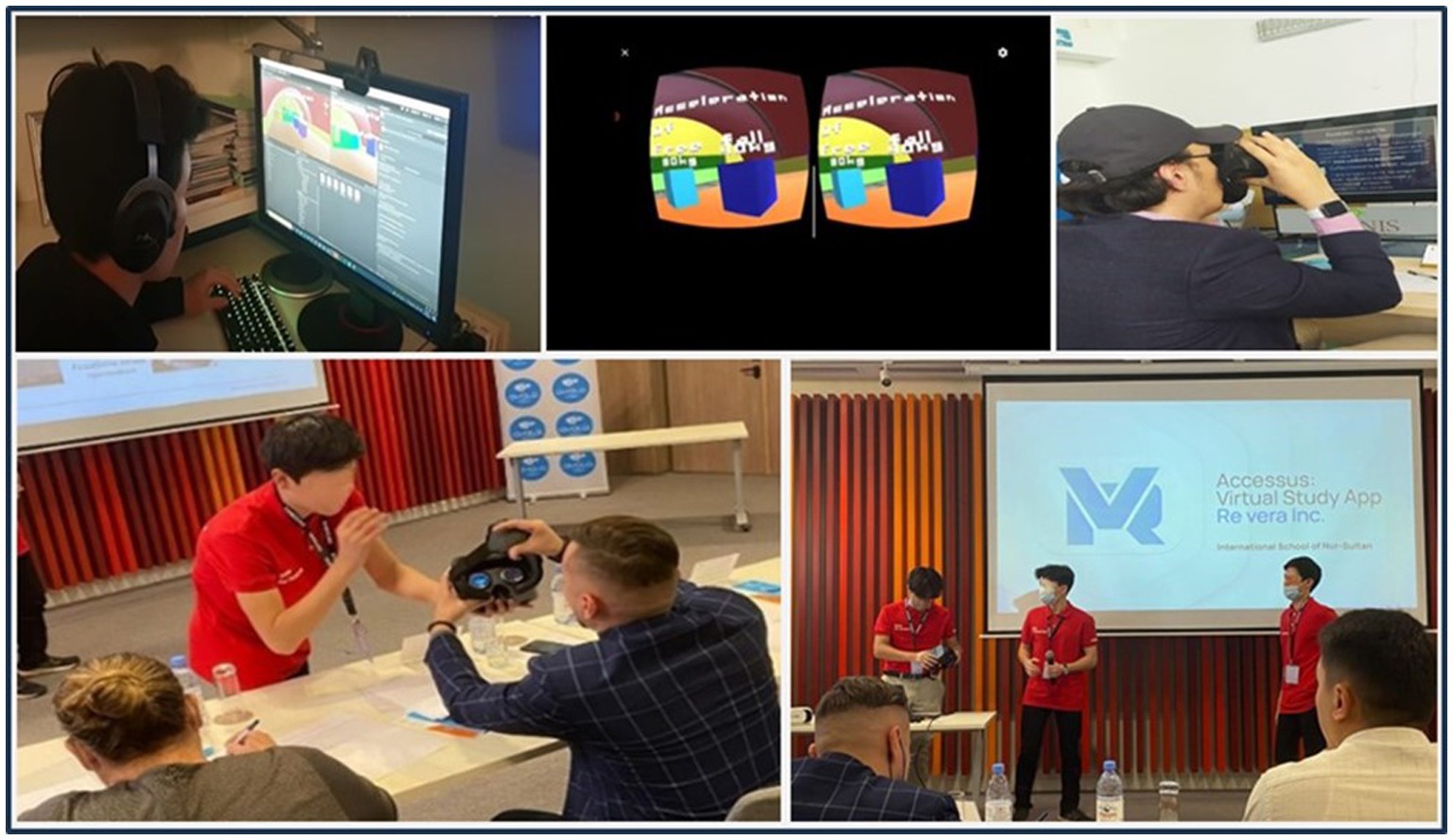
Figure 3. Integration of computer science skills in physics—a 10th-grade student creating virtual reality content.
4.6.3 Qualitative analysis of design projects
In the “Future Self” unit of the Design subject, students created 3D avatars that depicted their faces with envisioned changes over the coming years (see Figure 4). They also produced videos featuring these avatars, providing insights into their future selves and articulating their aspirations in terms of professions they anticipate in the future. The students used the Avaturn application.
As part of the 8th-grade curriculum, a student utilized the Blender program to craft a three-dimensional model of the merchant Kuprin’s house (see Figure 5). The student successfully translated this digital creation into a tangible form using a 3D printer for the final output. This individual project showcases the practical application of digital tools in the context of historical or literary exploration within the academic setting. An 8th-grade student undertook a creative endeavor by constructing a futuristic city model using the Sketch Up program (see Figure 6). This project demonstrates the application of digital design tools to envision and materialize innovative urban landscapes. Using Sketch Up showcases the student’s proficiency in digital modeling, fostering a practical link between technology and imaginative urban planning within the academic framework. A similar study demonstrated that experiential learning strategies using 3D Modeling and Printing enhances students’ comprehension of abstract scientific concepts and improves their hands-on abilities (Hsiao et al., 2018).
8th-grade students actively participated in the “Creating an application” unit as part of the Design curriculum, shown in Figure 7. The students undertook the process of developing applications, showcasing their practical application of design skills. The student’s engagement in this unit reflects the hands-on and applied nature of the curriculum. This aligns with the research study’s focus on evaluating the impact of digital literacy tools on student’s performance in Design. The image depicts students learning theoretical concepts and actively applying their knowledge in real-world scenarios through application development. This aligns with the study’s goals of enhancing student’s skills in working with digital tools and fostering creativity in problem-solving. The visible collaboration and engagement in the figure suggest a positive learning environment, contributing to the overall objectives of the research study. A more detailed breakdown of the application development process is in section 2.1 of Supplementary materials. Another study comparing the impact of computer-based instructional methods on students’ understanding and application of computational concepts revealed significantly higher performance in the plugged-in group using computers, particularly in the mastery and application of programming concepts (Sigayret et al., 2022). This indicates the efficacy of digital tools and hands-on experience in enhancing learning outcomes in Computer Science students.
4.6.4 Thematic analysis
The thematic analysis of teacher feedback regarding the integration of digital tools in the classroom revealed several key themes that underscored the impact of this intervention on students’ learning experiences and capabilities. These themes collectively illustrate the transformative effects of digital tool integration in educational settings, demonstrating not only improvements in specific skill areas but also broader enhancements in the educational approach and student preparedness for future challenges.
4.6.4.1 Enhanced technical proficiency
A notable theme that emerged from the feedback was the significant increase in students’ technical proficiency. Teachers observed that students became more adept at utilizing complex digital tools and platforms, which facilitated the creation of higher-quality project outputs. Notably, the use of software such as Blender and SketchUp enabled students to produce sophisticated 3D models and simulations.
4.6.4.2 Improved problem-solving skills
The analysis showed that students developed stronger problem-solving skills through their engagement with digital tools. The ability to troubleshoot issues during project development, refine their designs, and think critically about solutions was significantly enhanced. This improvement was particularly evident in projects that required students to apply their knowledge in practical settings, such as the creation of virtual reality content and mobile applications.
4.6.4.3 Increased creativity and innovation
Another significant theme was the increase in creativity and innovation among students. The feedback indicated that digital tools provided students with the means to express their ideas more freely and innovatively. This was reflected in projects involving creative design and digital art, where students experimented with new techniques and concepts.
4.6.4.4 Collaboration and engagement
Teachers reported improved collaboration and engagement among students, facilitated by digital platforms such as online whiteboards and collaborative software. These tools allowed students to work together more effectively, share ideas, and provide feedback to peers, which enhanced the learning experience and fostered a more interactive classroom environment.
4.6.4.5 Preparation for future challenges
The thematic analysis also highlighted that the use of digital tools in education prepared students for future academic and professional challenges. Teachers noted that students were developing a set of skills that are highly relevant in the digital age, such as digital literacy, data analysis, and the ability to use various technological tools, positioning them well for higher education and career opportunities.
4.6.4.6 Shift in educational dynamics
The analysis underscored a shift in educational dynamics, where traditional teaching methods were complemented or enhanced by digital tools. This shift allowed for a more dynamic and adaptive learning environment where teachers could tailor lessons more effectively to meet the diverse needs of students.
5 Discussion
The mixed-methods approach employed in this study facilitated a dual-layered analysis of the impact of digital literacy training at Astana International School. While quantitative data provided measurable outcomes of the training’s effectiveness, qualitative data offered rich insights into the contextual factors that influenced these outcomes. This dual analysis is critical, as it allows for a more nuanced understanding of how digital tools and training influence teacher performance and student learning across diverse contexts.
The educational intervention yielded positive results across various dimensions. Students exhibited an enhanced understanding of the fundamental principles in both Computer Science and Design, signifying a successful acquisition of foundational knowledge. Moreover, the intervention contributed to developing advanced skills in utilizing digital tools, encompassing graphic editors, programming languages, animation software, and more. This improvement in technical proficiency suggests a comprehensive and practical learning experience. Furthermore, the intervention notably fostered creativity among students, enabling them to apply acquired knowledge to real-world projects and problem-solving scenarios adeptly. This reflects theoretical understanding and practical and innovative application of skills.
The Substitution, Augmentation, Modification, and Redefinition (SAMR) model delineates various levels of technology integration in educational contexts, spanning from basic tool substitution to a complete redefinition of learning activities (Puentedura, 2010). The modification stage is more relevant to the current experiment and signifies a significant transformation through technology to reshape aspects of the learning process. Other researchers also highlight that mobile learning revamps the educational experience to empower learners with greater autonomy (Nikou and Economides, 2018). The modified pedagogy enhances student’s sense of control over the learning process and retention of factual knowledge. This transition toward student-centered learning underscores the pivotal role of technology in altering educational methodologies.
The educational initiative played a pivotal role in instilling confidence among students in their Computer Science and Design abilities. This newfound confidence suggests a positive shift in the students’ self-perception regarding their capabilities in these subjects. Additionally, the intervention aimed to kindle interest in further studies and potential careers in the fields of Computer Science and Design. While the results indicate a potential increase in students’ enthusiasm for continued education and future professional pursuits in these domains, it is essential to acknowledge the ongoing nature of these developments.
The educational intervention successfully achieved its objectives, positively influencing students’ understanding, skills, creativity, confidence, and potential future pursuits in Computer Science and Design. The results of the intervention experiments reveal significant advancements in Computer Science and Design education at Astana International School. The enhanced understanding of fundamental principles in these subjects is evident in the substantial improvement in students’ evaluation scores, particularly in the experimental groups. The utilization of digital tools played a pivotal role in this improvement, as teachers with digital literacy skills acquired through the training module effectively incorporated these tools, fostering an enriched learning environment. Additionally, the relationship between teacher differences, particularly in their TPACK competencies, and student outcomes emerged as a key finding. Teachers who had a more developed Technological Knowledge and were proficient in blending this with their Pedagogical Knowledge and Content Knowledge were able to facilitate more significant gains in student performance. This finding aligns with the TPACK framework’s emphasis on the integration of these knowledge domains, underscoring the importance of comprehensive teacher training. Our analysis suggests that the ability to effectively incorporate technology into teaching is not uniform among teachers, and this variability can have a substantial impact on student learning outcomes. This insight is critical for future professional development programs, which should focus on enhancing all aspects of TPACK to ensure that teachers are well-equipped to meet the demands of modern, technology-driven classrooms.
The intervention not only elevated skills in working with digital tools such as graphic editors, programming, and animation but also increased student creativity. This is demonstrated by the diverse and intricate projects, ranging from creating computer networks and databases to developing applications for environmental problem-solving. The positive correlation between exposure to digital literacy tools and heightened creative outputs underscores the efficacy of such interventions in nurturing well-rounded skill sets.
Furthermore, the intervention has instilled confidence in students regarding their Computer Science and Design abilities. The shift toward higher evaluation categories post-intervention reflects a newfound assurance and competence. Cultivating this self-assurance is crucial in motivating students to explore further studies and potential careers in Computer Science and Design. The possibility of an increased interest in these fields is an encouraging outcome, aligning with the broader goal of preparing students for the demands of the digital age.
Addressing the research questions, the effectiveness of developing digital literacy skills among teachers is evident in their successful integration of technology into the classroom. The existing levels of digital literacy among teachers at Astana International School substantially impact their ability to incorporate digital tools, with the intervention demonstrating a positive trajectory in this regard. The proficiency demonstrated by students in Grades 7 to 10 after exposure to digital literacy tools affirms the positive impact on their learning outcomes. Other researchers also highlight that interactive learning environments lead to notable improvements in aspects of knowledge acquisition and application thereby enhancing teacher’s digital competence (García et al., 2020). TPACK framework asserts that proficient teaching with technology requires an integration of technology, pedagogy, and content knowledge. Within TPACK, Technological Knowledge (TK) assesses teacher’s adeptness in utilizing digital technologies for educational objectives, Technological Content Knowledge (TCK) evaluates the amalgamation of content knowledge with technological tools, and Technological Pedagogical Knowledge (TPK) measures the efficacy of implementing teaching methodologies through technological channels (Chaipidech et al., 2022). The present experiment addresses all three aspects of TPACK. The teacher training program improves teacher’s technological knowledge and subsequently they rely on TCK and TPK to improve learning outcomes in students.
5.1 Main findings
The study revealed several significant outcomes related to the integration of digital literacy tools in teaching Computer Science and Design subjects at Astana International School. Teachers who received training in digital literacy tools demonstrated higher teaching effectiveness compared to those who did not undergo such training. This increased effectiveness translated into improved student performance, as evidenced by higher post-intervention scores in the experimental groups. Students exhibited enhanced technical proficiency, creativity, and problem-solving skills, indicating a comprehensive improvement in their learning outcomes. The thematic analysis of qualitative feedback further supported these findings, highlighting the positive impact of digital tools on student engagement and project quality.
5.2 Implications
These results have substantial implications for the field of educational research and practice. Firstly, the study underscores the critical role of teacher training in digital literacy for enhancing educational outcomes. By equipping teachers with the necessary digital skills, schools can significantly improve the effectiveness of their teaching methodologies, particularly in STEM and creative subjects. The findings also suggest that integrating digital tools into the curriculum can foster a more engaging and interactive learning environment, which is essential for developing student’s 21st-century skills. Policymakers and educational institutions should consider incorporating comprehensive digital literacy training programs for teachers to facilitate this transition. This research contributes to the broader discourse on digital literacy in secondary education, providing insights into effective interventions and their impact on student outcomes. The findings have practical implications for educators, policymakers, and curriculum developers, guiding the integration of digital literacy skills into the educational framework.
5.3 Future research directions
Future research should explore several avenues to build on the findings of this study. Longitudinal studies could provide deeper insights into the long-term impacts of digital literacy training on both teachers and students. Additionally, researchers should examine the effectiveness of specific digital tools and platforms in enhancing different aspects of learning and teaching. Expanding the scope to include diverse educational settings and age groups would also help generalize the findings. Finally, investigating the potential challenges and barriers to implementing digital literacy training and integrating digital tools in various educational contexts will inform more effective strategies for widespread adoption.
5.4 Limitations
Despite the positive outcomes, this study has several limitations that must be acknowledged and could inform future research. Firstly, the limited demographic scope of Astana International School, primarily involving middle school students and teachers within a specific educational environment, may not fully represent broader educational settings. This constrains the generalizability of the findings to other schools with different technological resources and cultural backgrounds.
Secondly, while the mixed-methods approach enriched the data, the reliance on self-reported measures for evaluating digital literacy improvements could introduce bias. Future studies could incorporate more objective measures, such as performance analytics from digital learning platforms, to provide a more nuanced understanding of how digital literacy impacts learning outcomes.
Additionally, the study’s design did not account for long-term follow-up with participants. Future research could explore the sustainability of the impacts observed, examining whether improvements in digital literacy and teaching efficacy persist, diminish, or evolve over time.
6 Conclusion
The research highlights the role of digital literacy enhancement in education and contributes substantively to the discourse on educational interventions through a meticulous research methodology that amalgamates quantitative rigor and qualitative nuance. The intervention experiments at Astana International School underscore the transformative potential of digital literacy education in shaping the landscape of Computer Science and Design learning. The positive outcomes affirm the efficacy of incorporating digital tools in the educational environment. The successful integration of technology by teachers, fueled by their participation in the training module, highlights the pivotal role of professional development in facilitating this transformation. Notably, the study revealed that teacher differences, particularly in their TPACK competencies—Technological Knowledge, Pedagogical Knowledge and Content Knowledge—significantly impacted student outcomes. Teachers who were proficient in integrating these domains were able to facilitate greater improvements in student performance, underscoring the importance of comprehensive teacher training in these areas. The progression from traditional offline formats to asynchronous online courses signifies adaptability to evolving educational paradigms, enabling teachers to pace their digital competence development independently. The findings shed light on the positive trajectory of digital literacy skills among teachers and their consequent impact on students’ learning experiences. These insights contribute to the broader discourse on digital literacy education and its implications for advancing education in the digital age.
Addressing the research questions has provided valuable insights into the effective development of digital literacy skills, existing levels among teachers, and the proficiency acquired by students. While challenges in digital transformation exist, the opportunities for enriching learning experiences through digital tools are substantial. The study advocates for the enhancement of TPACK competencies among teachers, highlighting that the ability to effectively integrate technology into teaching is not uniform and can significantly influence student learning outcomes. In the broader educational context, this research emphasizes the importance of fostering a culture of digital literacy to equip students and teachers alike for the demands of the digital age. The positive outcomes observed in this study serve as a catalyst for future endeavors in advancing digital literacy education, contributing to the evolution of educational methodologies, and preparing students for a technologically driven future.
Data availability statement
The original contributions presented in the study are included in the article/Supplementary material, further inquiries can be directed to the corresponding author.
Ethics statement
The studies involving humans were approved by the dissertation (PhD) research chairman of the commission on ethical evaluation Zhumagul Sagymbay Botpayevich. The studies were conducted in accordance with the local legislation and institutional requirements. The participants provided their written informed consent to participate in this study. Written informed consent was obtained from the individual(s) for the publication of any identifiable images or data included in this article.
Author contributions
MT: Writing – original draft, Writing – review & editing, Software. GA: Data curation, Writing – review & editing, Project administration, Methodology. CK: Validation, Visualization, Writing – review & editing.
Funding
The author(s) declare that no financial support was received for the research, authorship, and/or publication of this article.
Conflict of interest
The authors declare that the research was conducted in the absence of any commercial or financial relationships that could be construed as a potential conflict of interest.
Publisher’s note
All claims expressed in this article are solely those of the authors and do not necessarily represent those of their affiliated organizations, or those of the publisher, the editors and the reviewers. Any product that may be evaluated in this article, or claim that may be made by its manufacturer, is not guaranteed or endorsed by the publisher.
Supplementary material
The Supplementary material for this article can be found online at: https://www.frontiersin.org/articles/10.3389/feduc.2024.1408512/full#supplementary-material
References
Almenara, J. C., Gámez, F. D. G., Palmero, J. R., and Rodríguez, A. P. (2022). Teacher’s digital competence to assist students with functional diversity: identification of factors through logistic regression methods. Br. J. Educ. Technol. 53, 41–57. doi: 10.1111/bjet.13151
Belmar, H. (2022). Review on the teaching of programming and computational thinking in the world. Front. Comput. Sci. 4:997222. doi: 10.3389/fcomp.2022.997222
Chaipidech, P., Srisawasdi, N., Kajornmanee, T., and Chaipah, K. (2022). A personalized learning system-supported professional training model for teachers’ TPACK development. Comput. Educ. Artif. Intell. 3:100064. doi: 10.1016/j.caeai.2022.100064
García, C. R., García, O. B., and Lugo, P. D. P. (2020). Improving future teachers’ digital competence using active methodologies. Sustain. For. 12:798. doi: 10.3390/su12187798
Grover, S., and Pea, R. (2018). Computational thinking: a competency whose time has come. Comput. Sci. Educ. 19, 19–38. doi: 10.5040/9781350057142.ch-003
Hsiao, H.-S., Chen, J., Lin, C.-Y., Zhuo, P., and Lin, K.-Y. (2018). Using 3D printing technology with experiential learning strategies to improve preengineering students’ comprehension of abstract scientific concepts and hands-on ability. J. Comput. Assist. Learn. 35, 178–187. doi: 10.1111/jcal.12319
Koehler, M. J., and Mishra, P. (2008). Introducing Technological Pedagogical Content Knowledge. In AACTE Committee on Innovation and Technology. (Eds.), Handbook of Technological Pedagogical Content Knowledge (TPCK) for Educators. New York: Routledge. 3–29.
Martí, M. M., Romeu, T., Ojando, E. S., and González, V. E. (2022). Teacher digital competence: self-perception in education students pixel-bit. Rev. Medios Educ. 65, 275–303. doi: 10.12795/pixelbit.93208
Mukhtarkyzy, K., Abildinova, G., and Sayakov, O. (2022). The use of augmented reality for teaching Kazakhstani students physics lessons. Int. J. Emerg. Technol. Learn. 17, 215–235. doi: 10.3991/ijet.v17i12.29501
Mukhtarkyzy, K., Abildinova, G., Serik, M., Kariyeva, K., and Sayakov, O. (2023). Systematic review of augmented reality methodologies for high school courses. Int. J. Eng. Pedag 13, 79–92. doi: 10.3991/ijep.v13i4.38165
Nikou, S. A., and Economides, A. A. (2018). Mobile-based assessment: a literature review of publications in major referred journals from 2009 to 2018. Comput. Educ. 125, 101–119. doi: 10.1016/j.compedu.2018.06.006
Peñafiel, M. S. V., Nuñez, P., and Caza, J. C. (2023). Teachers’ digital competences in the context of COVID-19: a quantitative approach. Rev. Medios Educ. 67, 155–185. doi: 10.12795/pixelbit.98129
Peñalvo, F. J. G. (2018). Editorial computational thinking. IEEE Rev. Iberoamericana Tecnol. Del Aprendizaje 13, 17–19. doi: 10.1109/RITA.2018.2809939
Schneider, S., Krieglstein, F., Beege, M., and Rey, G. D. (2023). Successful learning with whiteboard animations—a question of their procedural character or narrative embedding? Heliyon 9:e13229. doi: 10.1016/j.heliyon.2023.e13229
Seemiller, C., and Grace, M. (2019). Generation Z: a century in the making. Oxford: Taylor and Francis Group.
Sentance, S., and Barendsen, E. (2018) in Computer science Education: Perspectives on Teaching and Learning in School. ed. C. Schulte (London: Bloomsbury Academic).
Sigayret, K., Tricot, A., and Blanc, N. (2022). Unplugged or plugged-in programming learning: a comparative experimental study. Comput. Educ. 184:104505. doi: 10.1016/j.compedu.2022.104505
Tokzhigitova, A., Yermaganbetova, M., and Tokzhigitova, N. (2023). Determining the activity of students through the elements of gamification. Int. J. Eng. Pedag. 13, 65–78. doi: 10.3991/ijep.v13i7.41885
Tong, D. H., Uyen, B. P., and Ngan, L. K. (2022). The effectiveness of blended learning on students’ academic achievement, self-study skills and learning attitudes: a quasi-experiment study in teaching the conventions for coordinates in the plane. Heliyon 8:e12657. doi: 10.1016/j.heliyon.2022.e12657
Turner, A. (2015). Generation Z: technology and social interest. J. Individ. Psychol. 71, 103–113. doi: 10.1353/jip.2015.0021
Yakubova, G., and Doughty, T. T. (2013). Brief report: learning via the electronic interactive whiteboard for two students with autism and a student with moderate intellectual disability. J. Autism Dev. Disord. 43, 1465–1472. doi: 10.1007/s10803-012-1682-x
Keywords: computer design, computer science, school education, teacher training, digital tools, digital skills, digital literacy, Kazakhstan
Citation: Temirkhanova M, Abildinova G and Karaca C (2024) Enhancing digital literacy skills among teachers for effective integration of computer science and design education: a case study at Astana International School, Kazakhstan. Front. Educ. 9:1408512. doi: 10.3389/feduc.2024.1408512
Edited by:
Judit García-Martín, University of Salamanca, SpainReviewed by:
Lucía Sánchez Bejerano, Universidad Europea del Atlántico, SpainWanda Nugroho Yanuarto, Muhammadiyah University of Purwokerto, Indonesia
Seyeoung Chun, Chungnam National University, Republic of Korea
Copyright © 2024 Temirkhanova, Abildinova and Karaca. This is an open-access article distributed under the terms of the Creative Commons Attribution License (CC BY). The use, distribution or reproduction in other forums is permitted, provided the original author(s) and the copyright owner(s) are credited and that the original publication in this journal is cited, in accordance with accepted academic practice. No use, distribution or reproduction is permitted which does not comply with these terms.
*Correspondence: Meruyert Temirkhanova, bWVydXllcnQuc2FpbGF1b3ZuYUBnbWFpbC5jb20=
 Meruyert Temirkhanova
Meruyert Temirkhanova Gulmira Abildinova1
Gulmira Abildinova1 Celal Karaca
Celal Karaca